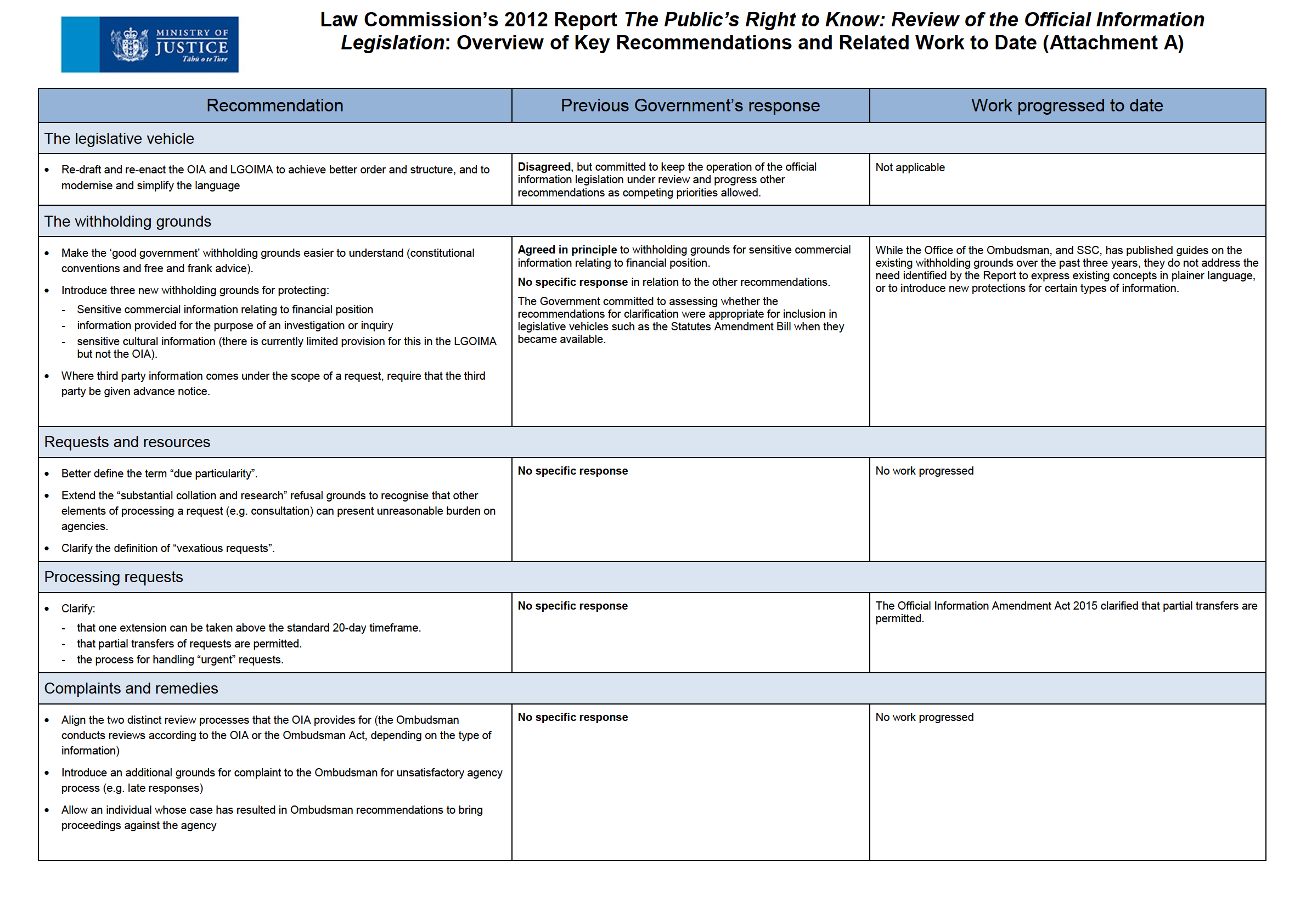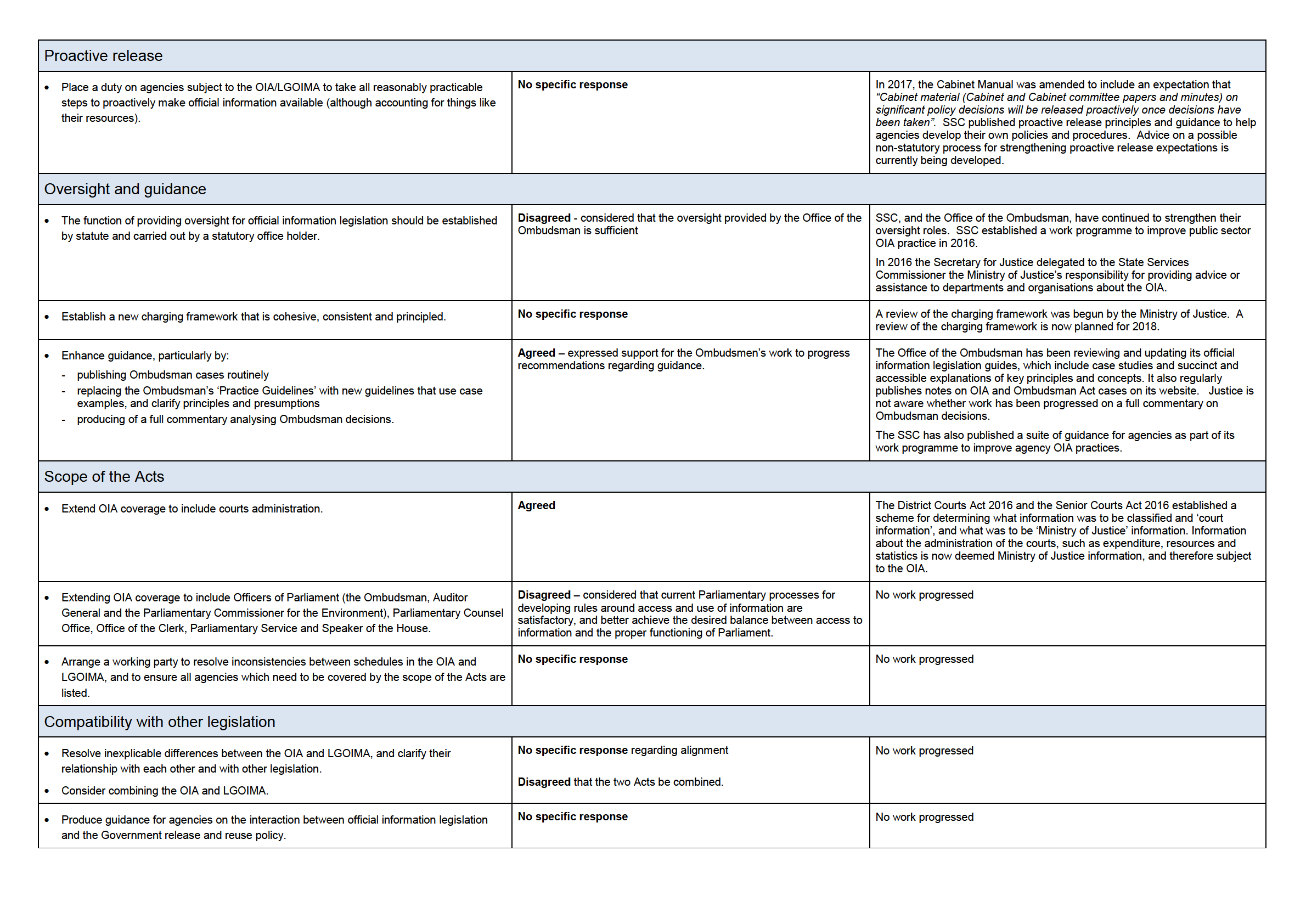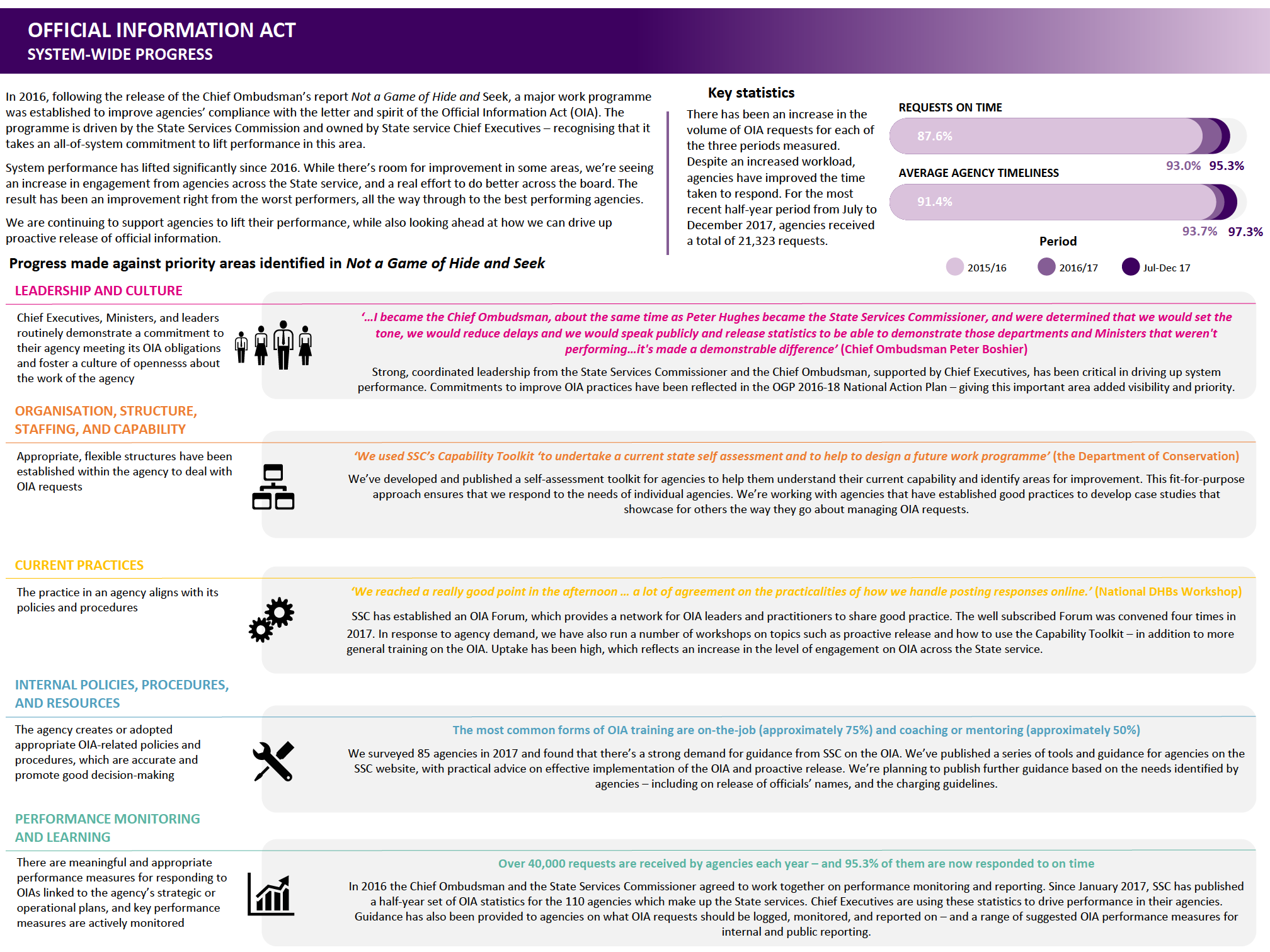K
ey Messages: Proposed approach in response to Ombudsman’s report on the OIA
1
Purpose
The following key messages are intended for the State Services Commissioner to deliver to
Chief Executives of government agencies.
The messages are in response to the Ombudsman’s report on the Official Information Act
released in December 2015, ‘Not a game of hide and seek’.
2
Key Messages
• As you know, the previous Ombudsman, Beverly Wakeham, released her report on the
implementation of the OIA – “Not a game of hide and seek” – in December.
• Her successor as Ombudsman, Peter Boshier, has also made some public comment in
recent weeks about the approach he intends to take, including an intention to publish
league tables on agency performance.
• The report found that things were not broken, but that there were areas of vulnerability
and opportunity to improve. This included matters of perception in relation to
Department’s handling of requests and their interaction with Ministers.
• The OIA still works and is generally implemented effectively. It is nevertheless important
that we collectively we take these messages on board, and take appropriate steps to
make improvements to our processes and address some of the perceptions about the
way we implement the Act.
• The Ombudsman’s report contains many recommendations, at different levels of detail,
some of which will be more relevant to some agencies than others. So where to start?
• At one level it is, of course, the responsibility of Chief Executives to ensure a system for
managing the OIA within their respective agencies is in place and they are complying.
Making information progressively available and responding to requests for information
is part of the core service agencies provide to the public.
• Andrew Bridgman (who has responsibility for administering the Act) and I consider that
there is also an opportunity to demonstrate responsiveness as a Public Service through
some quick wins that are low cost and which better utilise existing resources, and that
we can all deliver on if we are not already doing so.
• I would like us all to commit, over the next six months, to:
o Publish selected OIA responses on our websites, and consider a more proactive
approach when releasing information.
o Publish accessible information on making OIA requests together with and key
statistics on our websites.
o Review our OIA policies with respect to ‘no surprises’, consultation and charging.
o Ensure that appropriate training on the OIA is available to staff at all levels.
• Andrew and I will be leading by example on this.
Key messages: OIA report response
[INSERT SECURITY CLASSIFICATION]
• To support agencies in this work, the Ministry of Justice and SSC will provide updated
guidance on ‘no surprises’ and charging, and will highlight our existing guidance on
consultation with requestors.
• The Official Information Act forum, coordinated by the Ministry of Justice, is also there
to help agencies, develop and share best practice, and produce relevant guidance. In
2016 and 2017 we expect that it will focus on resources for requestors, guidance on
dealing with email and phone requests, applying the public interest test, and principles
for more proactive release of official information.
• Resources like the Forum only work to the extent that agencies make use of them, so I
encourage you to develop solutions to common issues together by using the forum,
rather that each of us reinventing our own wheels.
• Andrew and I also think that there is merit in facilitating an opportunity for CEs and senior
leaders to discuss the high-level issues directly with the Ombudsman and other
stakeholders with a perspective to offer. You can expect to hear more about this shortly.
• Finally, as recent media attention has demonstrated, effective engagement with the
Ombudsman is vital. The State Services Commission, along with the Ministry of Justice,
will be working with DPMC (where relevant) and others to engage with the Office of the
Ombudsman on the work it will be leading, to ensure that the overall effect is practical
and focused. This includes the issue of performance measures.
• Following this meeting you will each receive an email confirming what I have been talking
about with you today, and providing contact points for further information or enquiries.
Document1
[INSERT SECURITY CLASSIFICATION]
2
(In Confidence)
Head of State Services meeting with chief executives 22/23March 2016
Out of Scope
Maintaining a License to Operate
Out of Scope
.
Action Points:
• The State Services Commissioner Iain Rennie and Andrew Bridgeman to identify the
key issues from Dame Beverley Wakem’s report that require a system response and
draft a collective approach for CEs to review. The Commissioner, Andrew and Peter
Hughes to then meet with the Chief Ombudsman to discuss what we will focus on and
how.
• Out of Scope
2213978_1
Out of Scope
Out of Scope
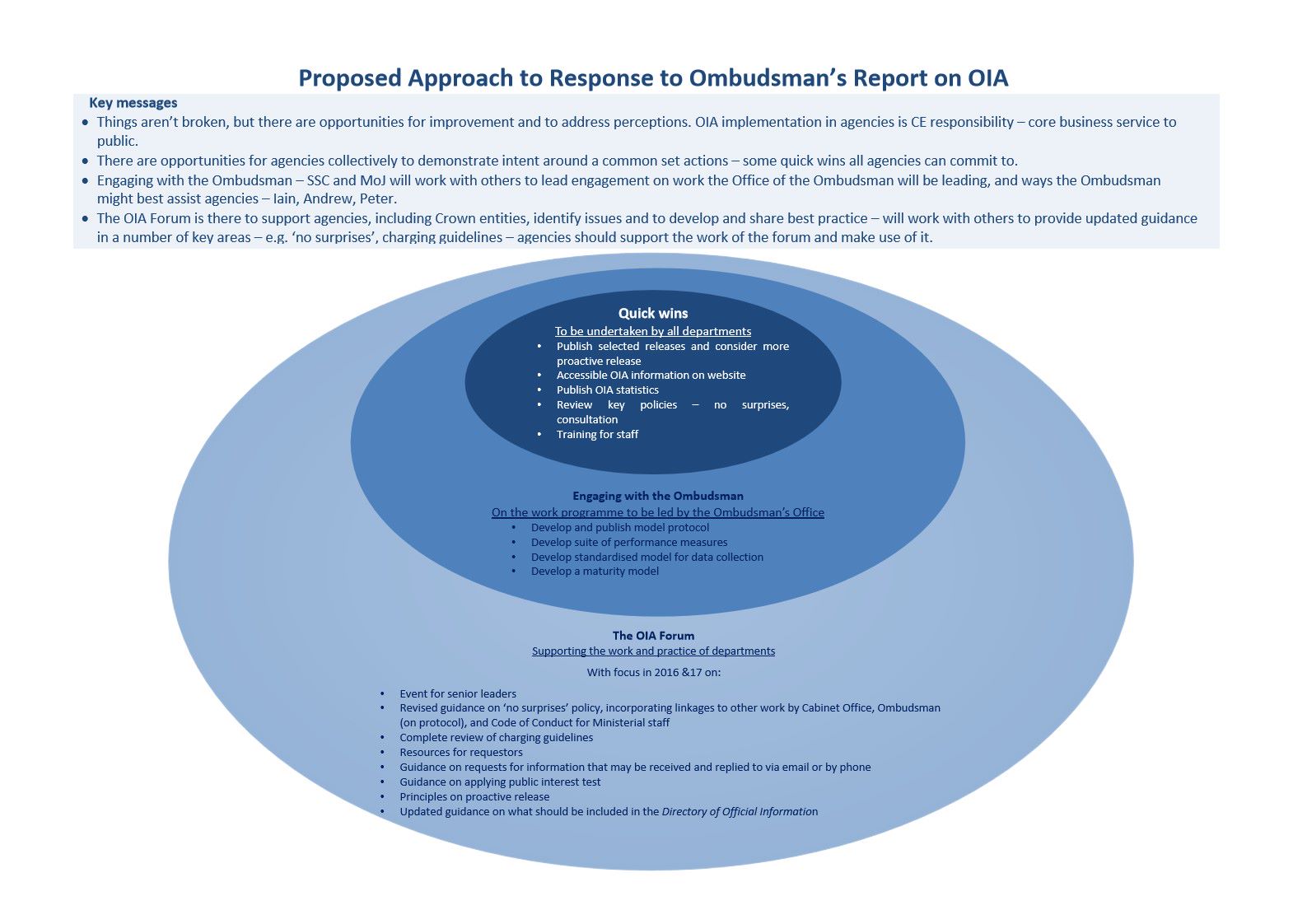
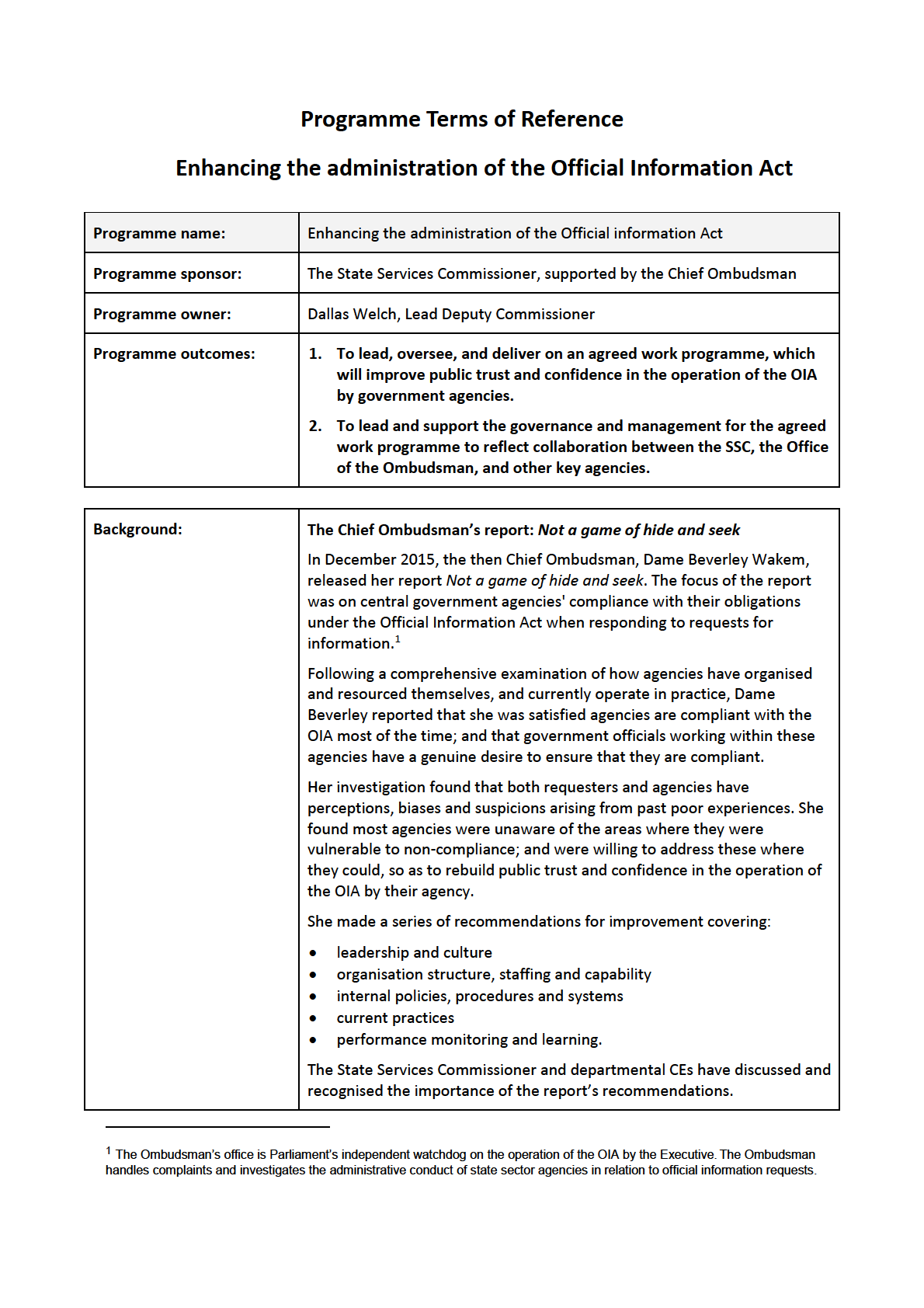
Background contd.
The Open Government Partnership (OGP)
The Open Government Partnership is an international multi-stakeholder
initiative of governments and civil society committed to making
governments more open, accountable, and responsive to citizens.
Launched in 2011, New Zealand joined in 2014.
http://www.opengovpartnership.org/country/new-zealand
At the same time as the engagement around improving OIA processes was
beginning, the SSC was also engaging with citizens’ groups and New
Zealanders to create the 2016-2018 National Action Plan under the OGP.
Numerous submissions on the Plan focused on improving the operation of
the OIA.
The Plan has been approved by Ministers. It includes a commitment to
improving official information practices, with a series of six initiatives to be
delivered between now and November 2017 in a work programme led by
the SSC in partnership with other key State sector agencies.
Bringing all this together – engagement between the SSC and the Office
of the Ombudsman
The State Services Commissioner and the Chief Ombudsman have separate
but complementary leadership roles and responsibilities in the State
services in relation to the Official Information Act. The Commissioner has
established a programme of work to improve government agencies’
capability in this area. A central aim of this programme is to improve
agencies’ official information practices in line with Dame Beverley’s
recommendations and to deliver on the OGP National Action Plan
(Commitment 2). The aims of the programme also align with the Chief
Ombudsman’s strategic focus on improving agency capability in the
processing of official information requests. The Commissioner and the
Chief Ombudsman have agreed that supporting each other’s work will
deliver a more effective result for agencies.
The focus of the programme work is threefold:
• To grow government agencies’ leadership in this area so that they can
confidently report on compliance with the letter and the spirit of the
Act
• To encourage pro-active release of official information, including
Cabinet papers and related material, building on existing good practice
• To advise and guide improvement in government agencies’ capability
to ensure more consistent performance.
The programme has the full support of Public Service chief executives.
The Chief Ombudsman and his Office have already identified a number of
areas for improvement, including publication of OIA statistics, measures of
performance in relation to the OIA, guidance and the approach to handling
OIA requests with Ministerial interests. These too are largely reflected in
the National Action Plan.
The Commission has further proposed that communication with
government agencies about the Ombudsman’s areas for improvement
should be framed in a way that reflects this approach.
This terms of reference sets out how that wil be done; and proposes a
work programme with a commitment to pro-active disclosure.
2
Programme Scope:
In scope
The actions and milestones in the proposed OGP National Action Plan for
2016-18 which relate to the OIA and which have been agreed by Ministers.
(See Attachment One).
Such other actions and milestones that may be directed by the Programme
Sponsors.
The context includes:
• The report
Not a game of hide and seek
• The Open Government Partnership
• Work done by the Office of the Ombudsman in response to
Not a
game of hide and seek.
Out of scope
The exercise by the Chief Ombudsman of his functions.
Any change to applicable legislation.
Programme structure:
Chair
Mary Slater
Steering Group
Office of the Ombudsman (Deputy Ombudsman
Bridget Hewson, Assistant Ombudsman Emma
Leach)
SSC (Erik Koed, Assistant Commissioner)
Ministry of Justice (Deputy Secretary Rajesh
Chhana)
DPMC (Deputy Secretary Cabinet Rachel Hayward)
DIA/GCIO (Helen Jamison, Government
Stakeholder Manager
Statistics NZ (Kelvin Watson, Deputy Government
Statistician)
Working group
SSC (Michael King, Mary Wiles, Sara Cunningham,
Morag McConville), Office of the Ombudsman
(Antonia Di Maio)
EA support
SSC (Leanne Kelly)
Methodology:
The Sponsor and the Chair will invite agencies to contribute personnel to
the SG and the WG.
The Chair and the Steering Group will:
• Discuss and agree their Terms of Reference, which will include:
− Establishing a work programme to deliver on the OGP National
Action Plan and other Actions/Milestones which may be agreed by
the Programme Sponsor in consultation with the Chief
Ombudsman
− Oversight of the establishment of the WG
− Meeting as needed to provide feedback on / agree the content of
3
Methodology contd:
proposed actions to meet the National Action Plan milestones
- Leading communication and consultation as needed with
government agencies on proposed actions to meet the
National Action Plan milestones. (This will include
engaging with the OIA Forum, and may include ad hoc
briefings to CEs/senior officials)
− Assuring the quality of work to meet the milestones
− Reporting to the Programme Sponsor and the Programme Owner
on progress, including any risks to delivery
− Deciding how the work programme will be evaluated
− Advising the Sponsor and the Owner in April 2017 whether and
how to continue the programme governance and management
arrangements.
The Working Group will prepare advice for the SG on:
• the current state for each of the milestones
• recommended option(s) to meet the milestones in order to improve
public trust and confidence in the operation of the OIA by government
agencies.
Deliverables:
The deliverables are the milestones.
Timeframes:
The Steering Group wil be established by Monday October 17 2016
The Working Group wil be in place and working by Tuesday 1 November
2016
The programme structure, and the work programme, will be reviewed by
31 March 2017. The SG wil then recommend future steps to the Owner
and to the Sponsor.
Reporting:
The Chair will report as required to the Programme Sponsor.
Interdependencies:
Work already done to enhance information sharing between the Public
Service and the Privacy Commissioner (see SSC #2240042).
Update of the Cabinet Manual.
Quality Assurance:
The SG will be responsible for quality assurance of the work programme.
Risks:
The primary risks are:
• The other key partners do not agree to be engaged
− To be managed / mitigated by the Chair consulting al on the ToR,
and as needed by a direct approach by the Sponsor
• The other parties do not commit the Working Group resource needed
to support the work programme
− To be managed / mitigated by a direct approach by the Owner
Evaluation:
The SG to consider how the work programme is to be both formatively and
summatively evaluated.
4
Resources:
Programme owner (Lead Deputy Commissioner) – total 12 hours
Four hours overseeing the Chair’s work
Two hours engaging with stakeholders (as required)
Four hours briefing the Sponsor
Two hours contingency
Programme director (Mary Slater) –
maximum 376 hours to end- March
2017)
Sixteen hours meeting the Programme Owner and key SSC staff, reviewing
background papers and preparing the terms of reference
Twenty four hours engaging with programme associates (OoO, MoJ,
others)
Forty hours preparing for, chairing, and undertaking follow up from SG
meetings (8 assumed)
Twenty-four hours engaging with stakeholders
Balance of time as needed with the Working Group etc.
Steering Group members – total forty hours (+ 16 for SSC member)
Forty hours preparing for, participating in, and undertaking fol ow up from
SG meetings (8 assumed)
SSC SG member – additional 16 hours drafting the SG ToR
Working Group members – 10
weeks each
To undertake the work outlined in the ToR
To develop resources to support engagement with stakeholders
To report to the SG
Executive assistant (tbc) – total 80 hours
Meeting support
Additional resource
In addition, specialist resource may be required to support individual
projects. This wil be identified by project leads as and when required.
Approval to Commence:
This must be signed off before the work programme can commence.
Date and sign-off
Programme Completion:
This will be signed off by the Programme Owner at the conclusion of the
Date and sign off
work programme, based on reporting by the Chair and the SG on
completion of the work set out in the ToR. Any exceptions to this wil be
noted through the reporting mechanisms.
Mary Slater
15 February 2017 (v10)
5
Attachment 1
Commitment 2: Improving official information practices
We will improve government agency practices around requests for official information under the Official
Information Act (OIA).
Objective: To make government information more accessible by adopting a consistent set of agency
practices in response to requests for official information.
Status quo: Practice around how agencies handle requests for official information is not uniform,
agencies are burdened by increasing administrative load around official information requests, and
people find it hard to navigate the system.
Ambition: We are committed to improving how government responds to requests for official
information.
Lead agencies: State Services Commission, Ministry of Justice
Timeline: October 2016 – June 2018
Commitment: Improving official information practices
OGP values
Access to information, civic participation, public accountability,
technology and information
New or ongoing
New
commitment
Lead implementation
State Services Commission, Ministry of Justice
organisations
Verifiable and measurable milestones to fulfil the
Start date
End date
commitment
Ensure information about the OIA (how to make
November 2016
March 2017
requests, etc) and responses to requests are easy to
access on agency websites. This could include
development of single OIA web pages for agencies.
Publish OIA statistics (how many requests, time taken November 2016
March 2017
to respond, etc)
(amended by
sponsor direction to
31 January 2017)
Develop a clear statement of government policy on October 2016
June 2017
proactive release of Cabinet papers and related
material
Develop a suite of consistent measures about OIA November 2016
November 2017
performance
Improve access to official information by publishing November 2016
February 2017
responses to requests on government websites and
developing principles for more proactive release
Agencies wil be supported to deliver through the November 2016
June 2018
development of appropriate guidance and training
6
M
emorandum
To:
Peter Hughes, Debbie Power
From:
Amy White
Copies to: Catherine Williams
Date:
24 July 2017
Subject:
Official Information Capability Assessment Tool
Background
1
The OIA work programme was initiated in late 2016 to help agencies meet the
government’s commitment in the OGP National Action Plan to improve management of,
and access to, official information (Commitment 2). As part of milestone six of this
commitment we have been developing a self-assessment tool for agencies to gauge their
capability and identify where they can improve.
2
This note outlines the prototype capability assessment tool and associated guidance, and
the next steps in its development.
The purpose of the self-assessment tool
3
The capability assessment tool has been developed to help agencies assess and improve
their official information practices.
4
It describes the key elements of capability as they relate to official information practices
within an agency, and poses a number of lead questions and lines of enquiry across those
elements. These provide a systematic way for agencies to understand their strengths and
weaknesses, and to identify and prioritise areas for improvement.
How it was developed
5
The capability assessment tool is based on the Performance Improvement Framework
(PIF) model and is intended to help agencies take a more in-depth look at how they
manage official information in order to lift capability, improve performance and support
learning and innovation.
6
The prototype has been developed with significant input from leaders and OIA
practitioners across 21 agencies. It reflects the key indicators of good practice that were
outlined in the former Chief Ombudsman’s report into central government agencies OIA
practices,
Not a game of hide and seek.
7
The Office of the Ombudsman was invited to provide feedback on the draft assessment
tool and guidance.
What the tool looks like
8
The capability assessment tool (see attached) is based on five domains of capability,
which have been identified as being critical to the effective management of official
information.
9
The tool is not prescriptive about what good looks like as this wil vary depending on the
agency’s context. Agencies with low volumes of OIA requests that are not overly complex
do not require the same operating model as a large, decentralised agency with large
volumes of OIA requests.
CAT strategy meeting memo 6 July.DOCXSECURITY CLASSIFICATION
10
Three versions of the tool with differing levels of detail cascading from high-level to in-
depth have been developed to support different levels of discussion and assessment for
a variety of audiences. In all cases, the assessment is undertaken as an improvement
exercise.
Pilot and feedback from agencies
11 The draft tools and associated guidance are currently being piloted by volunteer agencies
(DPMC, DIA, DoC, Maritime NZ, Health (tbc) and MBIE (tbc)) to test their usefulness in
assessing official information capability in differing agency contexts.
12 The prototype has been particularly well received by many of the agencies involved in its
development. A number of them have indicated to us that they are already using the draft
tools to assess their capability levels and identify areas for development.
Launch
13 We are proposing to launch the Official Information Capability Assessment Tool in
September to the agencies currently contributing OIA statistics to the six-monthly data
release that SSC coordinates with the Office of the Ombudsman.
14 We have had an initial conversation with the Communications team on possible
communications approaches, and we wil work with them over the next couple of months
to finalise key messages and appropriate channels for the release.
Risks and issues
15 There is one area to which we wish to draw your attention. We have recently discovered
that there is the potential for duplication of a self-assessment tool by the Office of the
Ombudsman.
16 When the OIA programme was being developed at SSC last year, representatives of the
Office of the Ombudsman indicated that they planned to develop OIA performance
indicators and a maturity model for agencies as part of their follow-up work on
Not a game
of hide and seek. After learning about our plans, they were relieved to hear that SSC was
intending to develop an assessment tool as this was not their area of expertise.
17 Since that point, staff from the office have been involved in the OIA programme through the
OIA Steering Group and have contributed to various pieces of our work. When the Office
released its strategy in early June, we were surprised to see that it includes “performance
measures and a maturity model that agencies can use to assess their own OIA practices
and capabilities”. No previous mention had been made that they were continuing this work.
18 The draft letter (attached) informs the Ombudsman of the work we are undertaking but
stops short of commenting on his work programme.
Attachments
1 Managing Official Information Capability Assessment Tool Guidance
2 Official Information Capability In-depth Assessment
3 Draft letter to the Chief Ombudsman
CAT strategy meeting memo 6 July.DOCXSECURITY CLASSIFICATION
2
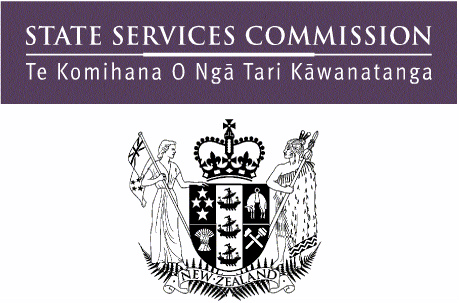 IN-CONFIDENCE
SSC Report:
IN-CONFIDENCE
SSC Report:
OIA Statistics Collection
Date:
20 December 2017
Report No:
SSC2017/725
Contact:
Catherine Wil iams
Telephone: 9(2)(a) privacy
Action Sought
Deadline
Associate Minister of State Services
Indicate whether you would like any
(Open Government)
further information.
(Hon Clare Curran)
Minister of State Services
Note the contents of this briefing
(Hon Chris Hipkins)
No action is required.
Enclosure:
No
Executive Summary
1
The paper responds to your request that we brief you on public sector agency
information and reporting requirements under the State Services Commission’s Official
Information Act (OIA) work programme.
2
You have also requested a briefing on progress in building capability and practice since
Dame Beverley Wakem’s report “Not a game of hide and seek”. We are preparing this
briefing and wil provide it in the new year.
Recommended Action
We recommend that you:
a
Note that
the next across agency OIA collection cycle has commenced and wil be
published in February 2018
b
Note that given the OIA applies to more agencies in the wider public sector than are
currently covered by the statistics collection, we expect to expand the number of
agencies included in the published statistics
c
Note that further questions wil be included in the July 2018 OIA statistics collection to
continue to monitor agencies’ adoption of proactive release practices.
Hon Clare Curran
Associate Minister of State Services
2302651
IN-CONFIDENCE
IN-CONFIDENCE
S SC Report: OIA Statistics Collection
Purpose of Report
3
The paper briefs you on public sector agency information and reporting requirements
under the State Services Commission’s (SSC’s) work programme on the OIA.
Background
4
Under Commitment Two of New Zealand’s Open Government Partnership Open
Government Partnership National Action Plan 2016-18, the Government has committed
to improving agency practices around requests for official information under the OIA.
Part of that commitment includes publishing OIA statistics and developing a suite of
consistent measures about OIA performance.
5
On 31 January 2017, SSC published the first-ever State services-wide set of OIA
statistics covering 110 agencies
1. This first set of data covered the 2015/16 financial
year and reported the number of logged OIA requests along with the number and
proportion handled within the legislated timeframe. The second set of statistics was
published on 5 September 2017 and covered the 2016/17 financial year.
6
Following the most recent collection, the State Services Commissioner wrote to all
agency CEs for whom OIA statistics were reported noting the performance of their
agency and seeking their personal leadership to support their agencies OIA practices
where they need improving.
Current collection
7
The current collection approach to OIA statistics captures the following five elements:
7.1 the number of requests received during a designated 6 month time period
7.2 the proportion of these requests where legislative timeliness requirements were
met
7.3 the number of responses proactively published on an agency’s website
7.4 the number of complaints investigated by an Ombudsman
7.5 the number of final views issued against an agency by an Ombudsman.
8
Following the collection and publication of OIA statistics from the 2015/16 and 2016/17
financial years, the next collection cycle has commenced and wil cover the six month
period 1 July to 30 December 2017. These data wil be published in February 2018.
Expansions of data sets
9
The SSC intends to continue to publish statistics on a six monthly basis. The scope
(range of reported statistics) and reach (number of agencies included) may expand over
time. SSC is also working to create a more consistent and comprehensive set of data for
1 OIA statistics were published centrally for al departments and Statutory Crown Entities subject to the Of icial Information Act
1982.
2302651
IN-CONFIDENCE
2
IN-CONFIDENCE
analysing agencies’ performance over time. The definitions of key statistics will be
standardised to improve consistency and comparability.
10 The OIA applies to more agencies in the wider public sector than are currently covered
by the statistics collection, and over time we expect to expand the number of agencies
included in the published statistics.
Proactive release policies and practices in agencies
11 In addition to your Cabinet paper currently underway on amending the proactive release
requirements on agencies, there is other work in train around proactive release.
12 The Commission has conducted an informal survey of agencies contributing to the OIA
statistics collection about their proactive release of official information. There were
responses from 86 agencies to our November survey. Data shows that agencies are
moving towards increased proactive release of information.
13 There were 12 agencies either having or expecting to have a proactive release policy in
place by the end of 2017, 14 agencies are currently developing a policy with
implementation expected in the new year, and a further 32 have indicated that
development of a policy is on their work programme.
14 The 6 monthly OIA statistics currently includes one question relating to the proactive
release of responses to OIA requests. Further question(s) wil be included in the January
- June 2018 collection (as the July-December 2017 collection is already underway) to
continue to monitor agencies’ adoption of proactive release practices.
2302651
IN-CONFIDENCE
3

Open Government - Holiday Reading Pack
Date:
20 December 2017
Report No:
SSC2017/820
Contact:
Catherine Williams Deputy Commissioner, Integrity Ethics and Standards
Telephone:
9(2)(a) privacy
Out of Scope
Hon Clare Curran
Associate Minister of State Services
(Open Government)
2304719
IN-CONFIDENCE
IN-CONFIDENCE
Out of Scope
2304719
IN-CONFIDENCE
2
IN-CONFIDENCE
Out of Scope
2304719
IN-CONFIDENCE
3
IN-CONFIDENCE
Out of Scope
2304719
IN-CONFIDENCE
4
IN-CONFIDENCE
Ope
n Government Programme
Key Points
•
Open government is necessary to meet the expectations of New Zealanders – it plays
an important role in New Zealand’s democratic system and underpins the public’s
respect, trust, and confidence in the integrity of government.
•
New Zealand does wel by international standards but needs to keep focussed to meet
evolving expectations
•
The State Services Commission (SSC) plays a leadership role across multiple
programmes of work that contribute to greater openness and transparency in
government and the wider state sector.
SSC has a leading role in building and maintaining high standards of integrity across the State
Services. Increasing the openness and transparency of government supports meeting the
increased expectations of citizens to be informed and engaged. Our commitment to Open
Government is a foundational pil ar in maintaining trust and legitimacy of government.
Work Programme
Focus
Outcomes
Official Information
Setting standards and
Improving government
providing guidance
agencies’ official
Capability development
information practice and
through Official Information
capability so that official
fora for leaders and
information is increasingly
practitioners, workshops and
available
seminars
Measuring OIA performance
by publishing statistics twice a
year
Proactive release
Guidance and capability
Supports
government
and
building
agencies to lift levels of proactive
Cabinet paper
release
Open Government
Leadership
SSC leads the development and
Partnership
implementation of the
National Action Plan
Delivering Commitment 2
SSC is responsible for delivering two
(official information) and 5
commitments in the National Action
(engagement)
Plan
International rankings
New Zealand is rated wel internationally:
• 1st in the Open Budget Index 2015 by the International Budget Partnership
•
1st equal with Denmark on Transparency International’s Corruption Perceptions Index
2016
•
2nd in the World Justice Project’s Open Government Index 2015
•
3rd equal with Australia, Luxembourg, and Uruguay in the Freedom in the World 2017
report by Freedom House
•
4th on the Economist Intel igence Unit’s Democracy Index 2016
•
7th on the Open Data Barometer
•
8th in the World Justice Project’s Rule of Law Index 2016
•
9th on the 2017 Social Progress Index
2304719
IN-CONFIDENCE
5
IN-CONFIDENCE
Out of Scope
2304719
IN-CONFIDENCE
6
IN-CONFIDENCE
Out of Scope
2304719
IN-CONFIDENCE
7
IN-CONFIDENCE
Out of Scope
2304719
IN-CONFIDENCE
8
IN-CONFIDENCE
Out of Scope
2304719
IN-CONFIDENCE
9
IN-CONFIDENCE
Offic
ial Information Statistics
Background
1.
Under Commitment Two of New Zealand’s Open Government Partnership Open
Government Partnership National Action Plan 2016-18, the Government has committed
to improving agency practices around requests for official information under the OIA.
Part of that commitment includes publishing OIA statistics and developing a suite of
consistent measures about OIA performance.
2.
On 31 January 2017, SSC published the first-ever State services-wide set of OIA statistics
covering 110 agencies1. This first set of data covered the 2015/16 financial year and
reported the number of logged OIA requests along with the number and proportion
handled within the legislated timeframe. The second set of statistics was published on 5
September 2017 and covered the 2016/17 financial year.
3.
Fol owing the most recent col ection, the State Services Commissioner wrote to al
agency CEs for whom OIA statistics were reported noting the performance of their
agency and seeking their personal leadership to support their agencies OIA practices
where they need improving.
Current collection 4.
The current col ection approach to OIA statistics captures the fol owing five elements:
4.1
the number of requests received during a designated 6 month time period
4.2
the proportion of these requests where legislative timeliness requirements were
met
4.3
the number of responses proactively published on an agency’s website
4.4
the number of complaints investigated by an Ombudsman
4.5
the number of final views issued against an agency by an Ombudsman.
5.
Fol owing the col ection and publication of OIA statistics from the 2015/16 and 2016/17
financial years, the next col ection cycle has commenced and wil cover the six month
period 1 July to 30 December 2017. These data wil be published in February 2018.
Expansions of data sets
6.
The SSC intends to continue to publish statistics on a six monthly basis. The scope (range
of reported statistics) and reach (number of agencies included) may expand over time.
SSC is also working to create a more consistent and comprehensive set of data for
analysing agencies’ performance over time. The definitions of key statistics wil be
standardised to improve consistency and comparability.
7.
The OIA applies to more agencies in the wider public sector than are currently covered
by the statistics col ection, and over time we expect to expand the number of agencies
included in the published statistics.
1 OIA statistics were published centrally for all departments and Statutory Crown Entities subject to the Official Information Act 1982.
2304719
IN-CONFIDENCE
10
IN-CONFIDENCE
Proa
ctive release policies and practices in agencies
8.
In addition to your Cabinet paper currently underway on amending the proactive
release requirements on agencies, there is other work in train around proactive release.
9.
The Commission has conducted an informal survey of agencies contributing to the OIA
statistics col ection about their proactive release of official information. There were
responses from 86 agencies to our November survey. Data shows that agencies are
moving towards increased proactive release of information.
10. There were 12 agencies either having or expecting to have a proactive release policy
in place by the end of 2017, 14 agencies are currently developing a policy with
implementation expected in the new year, and a further 32 have indicated that
development of a policy is on their work programme.
11. The 6 monthly OIA statistics currently includes one question relating to the proactive
release of responses to OIA requests. Further question(s) wil be included in the January -
June 2018 col ection (as the July-December 2017 col ection is already underway) to
continue to monitor agencies’ adoption of proactive release practices.
2304719
IN-CONFIDENCE
11
IN-CONFIDENCE
Appe
ndix
Official Information Act response times improving Information source – SSC Website
Published: 5 September 2017
Last updated: 5 September 2017
State Services Commissioner Peter Hughes has today published the Official Information Act
statistics for the 2016/17 year showing an improvement in the timeliness of responses.
Agencies responded to 93% of all requests on time (39,000 of 41,935 in total), which is up 5.4
percentage points from the 87.6% recorded for 2015/16.
“Government agencies need to be open and transparent with New Zealanders,” Mr Hughes
said. “When New Zealanders ask us for information we need to respond properly every time.”
The latest statistics cover 111 different agencies who col ectively handled 41,935 requests,
which is a 4.1% increase on the 40,273 requests in 2015/16. The number of requests to each
agency ranged from 0 to 11,257 with a median number of 73.
Agency on-time performance ranged from 62.9% to 100% of requests handled within
legislated timeframes. A total of 40 agencies achieved 100% on time performance.
“It’s good to see that timeliness is improving, but there is stil plenty to do,” Mr Hughes said.
“The Official Information Act sets clear timeframes for responses and we need to be meeting
them every time,” he said.
District Health Boards have improved overall, with the median on time performance across
the group increasing from 82.4% to 88.8%, and 15 of the 20 DHBs improving. However, DHBs
remain the poorest performing group overall.
“The increase in timeliness is good to see but DHBs need to keep working hard as significant
improvement is stil required,” said Mr Hughes.
“A small number of Public Service departments showed poorer on-time performance than
last year. This is not good enough and I have written to the Chief Executives asking them to
provide me their plans to improve their agency’s performance in this area,” said Mr Hughes.
By contrast, the Departments of Conservation and Corrections both handled significantly
more requests this year (53% and 39% increases respectively)
and improved timeliness
performance (from 73% to 90% and from 91% to 97% respectively).
“This is an excel ent result and I commend the Chief Executives and staff of these agencies
for their commitment and hard work,” Mr Hughes said.
Six agencies (NZSIS, GCSB, Civil Aviation Authority, Ministry of Justice, Ministry for the
Environment and Heritage NZ) reported degraded timeliness performance as a result of
restricted building access fol owing the Kaikoura earthquake in November 2016.
SSC wil be publishing a range of OIA guidance material over the coming months. This
material is designed to give useful and practical assistance and help streamline the process
for State servants who respond to OIA requests. This guidance is being developed with
assistance and advice from the Office of the Ombudsman.
“This guidance wil help agencies improve their processes and help staff to get the responses
right,” said Mr Hughes
2304719
IN-CONFIDENCE
12

Official Information Act: Overview of Changes Since Law Commission (2012) and
Ombudsman (2015) Reports
Date:
16 March 2018
Security Level:
In Confidence
For:
Hon Clare Curran, Associate Minister of State Services (Open Government)
Report No:
SSC2018/251
Official Information Act: Overview of Changes Since Law Commission (2012) and
Ombudsman (2015) Reports
Purpose
This paper includes a set of A3s that provide:
• An overview prepared by the State Services Commission of progress on
the recommendations in the Chief Ombudsman’s 2015 report
Not a
game of hide and seek, and
• An overview prepared by the Ministry of Justice of the Law Commission’s
2012 report
The Public’s Right to Know: Review of the Official Information
Legislation.
Minister
Hon Clare Curran, Associate Minister of State Services (Open Government)
Background
You requested an overview of progress since the Chief Ombudsman’s 2015
report
Not a game of hide and seek, and information on what has happened
since the Law Commission’s 2012 review of the Official Information Act.
Chief Ombudsman’s The attached A3
summarises the work completed to date by the State Services
recommendations
Commission and what is being planned for the future, against the five priority
on agency
areas identified in the report.
practices
The OIA work programme focuses on lifting agency performance in three key
areas – compliance with the Official Information Act, proactive release of
information, and building agency capability. It will has a particular focus on
proactive release in 2018.
Law Commission’s
The attached table from the Ministry of Justice summarises the Law
recommendations
Commission’s key recommendations along with how the previous Government
on official
chose to respond and the work that has been progressed to date.
information
legislation
Next steps
We are working with the Ministry of Justice to provide a follow-up report by 23
March on possible approaches to the question of legislative change, for your
consideration.
Author: Mary Wiles, Capability Specialist, Integrity, Ethics and Standards
Responsible Manager: Erik Koed, Assistant Commissioner
None
IN-CONFIDENCE
1
